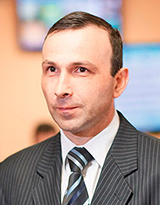The phenomenology of inertial kinematics in the structure of forming motor adaptations
https://doi.org/10.35596/1729-7648-2020-18-5-62-70
Abstract
The aim of the study was to develop a methodology for assessing the state of motor adaptation at the level of the main joint elements of the locomotor system when performing postural deviations with inertial components in a group of healthy volunteers (n=24). To conduct the study we used the “Teslasuit” smart suit as a technology with a system of inertial measuring units. A virtual skeletal model of the subject’s body was reconstructed on the obtained quaternions for each direction of spatial displacement. Parameters of inertial kinematic were calculated by the Fast Fourier Transform in the frequency bands of 0.1–5, 6–10, and 11–15 Hz. To assess motor adaptive reactions, we developed the following tests: ventrodorsal displacement test; laterolateral displacement test; linear displacement test in vertical direction; axial rotation test around vertical. All test tasks were performed using biofeedback as a virtual reality environment. The study revealed the presence of universal motor adaptation mechanisms with activation of the components of axial rotation of the trunk and axial rotation and flexion of the leading shoulder joint. At the same time, a dynamic phase of postural regulation during axial rotations and tilts of the body leads to the activation of motor adaptation mechanisms from the leading hip, knee, and ankle joints, while axial movements form a picture of the kinematic stabilization of these locomotor system elements.
About the Authors
U. A. LukashevichBelarus
Lukashevich Uladzislau Anatolyevich, PhD, Doctoral candidate
220013, Minsk, P. Brovka Str., 3, building 3
tel. +375-44-566-11-22
U. U. Ponomarev
Belarus
D.Sci, Professor, Head of the Department of Neurology and Neurosurgery
Minsk
U. E. Mitskevich
Belarus
Вiomedical Engineer
Minsk
S. V. Gubkin
Belarus
D.Sci., Professor, Director of the Institute of Physiology
Minsk
Y. A. Gavrilovich
Belarus
Bachelor, Software Engineer
Minsk
E. A. Zhurko
Belarus
Bachelor, Software Engineer
Minsk
A. N. Kipel
Belarus
Bachelor, Mathematician
Minsk
References
1. Lieber R.L., Fridén J. Functional and clinical significance of skeletal muscle architecture. Muscle Nerve. 2000;23(11):1647-66. DOI: 10.1002/1097-4598(200011)23:11<1647::aid-mus1>3.0.co;2-m.
2. Loudon J.K. Biomechanics and pathomechanics of the patellofemoral joint. Int J Sports Phys Ther. 2016;11:820-830. PMC5095937.
3. Almarwani M., Van Swearingen J.M., Perera S., Sparto P.J., Brach J.S. Challenging the motor control of walking: Gait variability during slower and faster pace walking conditions in younger and older adults. Arch. Gerontol. Geriatr. 2016;66:54-61.
4. Sawicki G.S., Sheppard P., Roberts T.J. Power amplification in an isolated muscle-tendon unit is load dependent. J Exp Biol. 2015;218(22):3700-3709. DOI: 10.1242/jeb.126235.
5. Ozinga S.J., Machado A.G., Koop M.M., Rosenfeldt A.B., Alberts J.L. Objective Assessment of Postural Stability in Parkinson’s Disease Using Mobile Technology Mobile Technology for Assessment of PD Postural Stability. Mov. Disord. 2015;30:1214-1221.
6. Lieber R.L., Fridén J. Spasticity causes a fundamental rearrangement of muscle-joint interaction. Muscle Nerve. 2002;25(2):265-270. DOI: 10.1002/mus.10036.
7. Boakes J.L., Foran J., Ward S.R., Lieber R.L. Muscle adaptation by serial sarcomere addition 1 year after femoral lengthening. Clin Orthop Relat Res. 2007;456:250-263.
8. Arnold E.M., Ward S.R., Lieber R.L., Delp S.L. A model of the lower limb for analysis of human movement. Ann Biomed Eng. 2010;38(2):269-279. DOI: 10.1007/s10439-009-9852-5.
9. Takakusaki K., Tomita N., Yano M. Substrates for normal gait and pathophysiology of gait disturbances with respect to the basal ganglia dysfunction. J Neurol. 2008;255(4):19-29. DOI: 10.1007/s00415-008-4004-4007.
10. Holt N.C., Roberts T.J., Askew G.N. The energetic benefits of tendon springs in running: is the reduction of muscle work important? J Exp Biol. 2014;217(24):4365-4371. DOI: 10.1242/jeb.112813.
11. Lieber R.L., Roberts T.J., Blemker S.S., Lee S.S.M., Herzog W. Skeletal muscle mechanics, energetics and plasticity. J Neuroeng Rehabil. 2017;14:108. DOI: 10.1186/s12984-017-0318-y PMID: 29058612.
12. Roberts T.J., Konow N. How tendons buffer energy dissipation by muscle. Exerc Sport Sci Rev. 2013;41(4):186-193. DOI: 10.1097/JES.0b013e3182a4e6d5.
13. Fukunaga T., Kubo K., Kawakami Y., Fukashiro S., Kanehisa H., Maganaris C.N. In vivo behaviour of human muscle tendon during walking. Proc Biol Sci. 2001;268(1464):229-233. DOI: 10.1098/rspb.2000.1361.
14. Gao F., Grant T.H., Roth E.J., Zhang L.Q. Changes in passive mechanical properties of the gastrocnemius muscle at the muscle fascicle and joint levels in stroke survivors. Arch Phys Med Rehabil. 2009; 90(5):819-826. DOI: 10.1016/j.apmr.2008.11.004.
Review
For citations:
Lukashevich U.A., Ponomarev U.U., Mitskevich U.E., Gubkin S.V., Gavrilovich Y.A., Zhurko E.A., Kipel A.N. The phenomenology of inertial kinematics in the structure of forming motor adaptations. Doklady BGUIR. 2020;18(5):62-70. (In Russ.) https://doi.org/10.35596/1729-7648-2020-18-5-62-70































